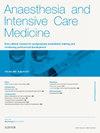Anaesthesia for eye surgery in paediatrics
IF 0.3
Q4 ANESTHESIOLOGY
引用次数: 0
Abstract
In contrast to adult practice, the majority of paediatric eye surgery is performed under general anaesthesia. Most patients presenting on a paediatric ophthalmology operating list will be otherwise healthy children who are suitable for day surgery. However, some children may present with eye pathology as part of a congenital disorder. The perioperative plan should be formulated after assessment of the child’s behaviour and medical comorbidities, taking into account the surgical conditions required for the intended procedure. Factors influencing intraocular pressure (IOP) may require careful manipulation, and anaesthetists should be vigilant of the oculocardiac reflex (OCR). Postoperative nausea and vomiting (PONV) is more common in ocular surgery, particularly following strabismus correction. In most cases, simple analgesics and intraoperative application of topical local anaesthesia are sufficient to provide effective postoperative pain relief.
儿科眼科手术麻醉
与成人手术不同,大多数儿科眼科手术是在全身麻醉下进行的。大多数出现在儿科眼科手术名单上的病人将是健康的儿童,他们适合日间手术。然而,有些儿童可能表现为先天性疾病的一部分。围手术期计划应在评估儿童的行为和医疗合并症后制定,同时考虑到预期手术所需的手术条件。影响眼内压(IOP)的因素可能需要仔细操作,麻醉师应警惕心眼反射(OCR)。术后恶心呕吐(PONV)在眼科手术中更为常见,尤其是斜视矫正手术后。在大多数情况下,简单的镇痛药和术中局部麻醉足以提供有效的术后疼痛缓解。
本文章由计算机程序翻译,如有差异,请以英文原文为准。
求助全文
约1分钟内获得全文
求助全文
来源期刊

Anaesthesia and Intensive Care Medicine
ANESTHESIOLOGY-
CiteScore
0.50
自引率
0.00%
发文量
152
期刊介绍:
Anaesthesia and Intensive Care Medicine, an invaluable source of up-to-date information, with the curriculum of both the Primary and Final FRCA examinations covered over a three-year cycle. Published monthly this ever-updating text book will be an invaluable source for both trainee and experienced anaesthetists. The enthusiastic editorial board, under the guidance of two eminent and experienced series editors, ensures Anaesthesia and Intensive Care Medicine covers all the key topics in a comprehensive and authoritative manner. Articles now include learning objectives and eash issue features MCQs, facilitating self-directed learning and enabling readers at all levels to test their knowledge. Each issue is divided between basic scientific and clinical sections. The basic science articles include anatomy, physiology, pharmacology, physics and clinical measurement, while the clinical sections cover anaesthetic agents and techniques, assessment and perioperative management. Further sections cover audit, trials, statistics, ethical and legal medicine, and the management of acute and chronic pain.
 求助内容:
求助内容: 应助结果提醒方式:
应助结果提醒方式:


